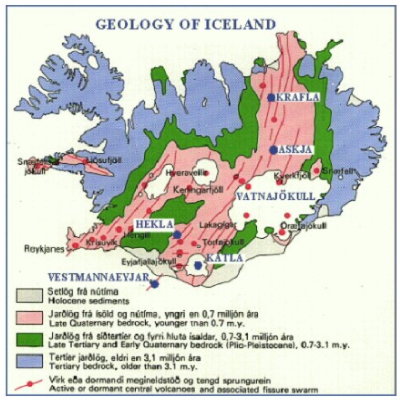
The Bardarbunga volcano is rumbling
Icelandic volcanoes are in the news again with the threatened eruption of the Bardarbunga volcano located beneath the Vatnajökull glacier. You may remember that in 2010 ash spewing from the Eyjafjallajokull volcano disrupted air traffic throughout Europe.
Iceland, which is about one-third the size of Arizona, has 30 or so volcanoes considered active. Imagine having 30 active volcanoes concentrated in southern Arizona. (Once upon a time there were…, see A brief geologic history of Arizona Chapter 5: Jurassic Time.)
Geologic Setting
Iceland sits astride the Mid-Atlantic Ridge (see map below), a boundary between two tectonic plates where new crust is being formed by volcanic eruptions as the plates diverge. Movement on this structure over the last 180 million years or so has separated Europe from North America, and Africa from South America. The island of Iceland is engaged in a geologic race between the spreading motion which is ripping the island apart, and the volcanoes which are building the island up.
Other islands of the Atlantic Ocean created by the volcanism of the Mid-Atlantic Ridge are the Azores, Bermuda, Madeira, Canary Islands, Ascension, St. Helena, and Tristan da Cunha. But, you probably haven’t heard about any volcanoes erupting in Bermuda because that island group lacks one other geologic phenomenon: the “hot spot.” Iceland also sits above a mantle plume or “hot spot” where magma from deep in the mantle forces its way to the surface. The Hawaiian Islands were formed, and are being formed, by such a hot spot. In Hawaii, the westward movement of the Pacific plate passes over this hot spot and eruptions produce new islands. Iceland, however, is not moving in such a manner.
The major plate boundaries are shown on the map below.
The general geology of Iceland is shown on the map below from the Nordic Volcanology Institute.
The pink area on the map represents the rifts along the Mid-Atlantic Ridge where the crust is separating and the volcanoes are most active. Of Iceland’s 100 most active volcanoes, 25 have erupted in recent history, and 35 volcanoes have erupted in the last 10,000 years. Eleven volcanoes have erupted between 1900 and 1998. Most of the eruptions were from fissures or shield volcanoes and involve the effusion of basaltic lava.
The 1783 to 1784 eruption at Laki fissure and the adjoining Grímsvötn volcano was the largest single historic eruption of basaltic lava (12 cubic km). Benjamin Franklin, who at the time was serving as ambassador to France remarked on this eruption. The ash cloud caused the “year without summer.” That eruption of basalt lava and clouds of poisonous hydrofluoric acid/sulfur-dioxide compounds killed over 50% of Iceland’s livestock population, leading to famine which killed approximately 25% of the population.
Volcanologist Dave McGarvie has an article about what could happen next with the rumbling Bárðarbunga volcano. See full story here. “At the very least, magma will stall in the Earth’s crust and form an intrusion. We may never see any manifestation of this, except on instruments. But if magma does break through to the surface, then how much magma erupts and what is above it will determine the eruption style…If magma breaks to the surface outside the glacier margin, there are likely to be small but powerful local explosions as the rising magma encounters the water-bearing sediments that occupy the land in front of the glacier margin.”
See other stories of geology on ADI:


